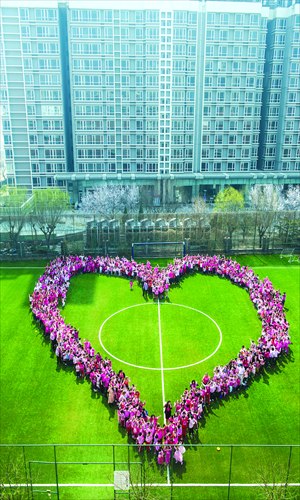
Students gather on the field of the Canadian International School on April 2 dressed in pink to commemorate Pink Shirt Day. Pink is the international anti-bullying color. Photo: Li Hao/GT
When Celita Epalanga, 12 years old, first moved with her family from Angola to Beijing, two things stood out about her to her new classmates at the Canadian International School of Beijing: her skin color and non-fluent English.
"In fourth grade, I went up to someone to say, 'Hi,' and he told me that he didn't like African people," she said.
As bullying often stems from perceived differences, international schools with a host of different cultures and backgrounds may seem like the perfect storm for rampant bullying.
Celita talked about the issue with her mother, who said that not everyone needs to like everyone else - but that respect is a crucial element.
Luckily, Celita's enthusiastic personality won others over easily, and by the end, the teasing boy became a friend. Despite marked differences, she escaped being taunted. Others who don't or can't stand up to bullies may be less fortunate.
In any case, distinguishing between kids being kids, bullying and cultural nuances remains a murky matter at international schools.
Who is bullying?
Stopbullying.gov, an anti-bullying website based in the US, defines bullying as "unwanted, aggressive behavior among school-aged children that involves a real or perceived power imbalance." This type of behavior may be repeated over time. Bullying includes "making threats, spreading rumors, attacking someone physically or verbally, and excluding someone from a group on purpose."
Bullying sometimes defies the definitions, though, as it doesn't just include physical violence and intimidation. Often in high school, bullying turns more psychological. Bullying at international schools may be harder to pinpoint, as it can be more about cultural divides, a touchy subject.
"International schools in Beijing stand as unique for their many different nationalities, whether it's kids from a Chinese, Korean or Canadian background," said Adam Wilson, a guidance counselor at the Canadian International School of Beijing. This mix of nationalities can sometimes contribute to cultural miscommunications. Cliques can emerge.
A 10-year-old boy of Korean nationality (who requested anonymity) describes a typical recess break at the playground of his international school: "Usually, the Koreans hang out with the Koreans and the Chinese with the Chinese. … Then there are the kids from France, the UK and (Europe), and they tend to hang out with each other. It's not that they don't talk to you or anything, but they might not let you play ball with them."
"Often, bullies tend to want power. It's just an imbalance of power in their life that they are trying to make up for. They don't know how to express themselves, so they act physically," Wilson said. "There might be cases where they don't understand the impact of their actions. We try to help them with that problem in their life, or just give them solutions."
As bullying and its damages are on the rise everywhere, international schools in Beijing are gearing up on preventative measures.
Dulwich College Beijing, which offers classes for kids ages 1 to 18, held a parent seminar recently called "Why Children Bully" at its main campus at Legend Garden, Shunyi district. Dulwich invited Robert Pereira from Australia, an educational consultant in the area of school bullying and author of a resource called "Why We Bully."
This seminar strove to assist parents understand the causes of bullying, providing parents with the bigger picture behind this social problem and enabling them to engage in conversation with their sons and daughters to minimize this growing problem.
Cyberbullying
Wilson worked as a guidance counselor for a year in Canada before starting at the Canadian International School in Beijing. One marked difference, Wilson said, is that in smaller cities and towns in Canada, the student body tends to live close together. But at most international schools in Beijing, students' homes sprawl all over the city. This means that to keep in touch when they go home, they head online, Wilson said.
Though bullying may have once happened largely in the classroom and the playground, the Internet is a free-for-all space, without restrictions or supervision from parents, principles and teachers.
Cyberbullying, as the Western Academy of Beijing explains, takes place in the digital sphere and involves both Internet and cell phone communication. Examples of cyberbullying include circulating false rumors about someone on social networking sites, sending threatening or provocative e-mails and texts and publishing mean comments about another person online.

Copyright ©1999-2011 Chinanews.com. All rights reserved.
Reproduction in whole or in part without permission is prohibited.